Product engineering is an essential and ongoing part of any business that wants to innovate and stay competitive. However, it comes with its fair share of challenges that even the most successful product companies sometimes have to deal with. But, solving those challenges would be worth a bar of gold, as the global product engineering services market will reach USD 1,002.9 billion by 2026, growing at a CAGR of 8.8%.
With such humongous growth and business potential, product engineering is the way forward. However, to leverage its true potential, you, as a product manager, must know the common hurdles in the path of product engineering and possible ways to mitigate them. Let’s take a look at the top challenges you may encounter while building your product and how we can help you overcome them.
Common product engineering challenges and possible solutions
Product engineering is a complex process that involves various stages of designing, developing, and testing a product. The goal of these processes is to ensure the product meets customer needs and regulatory standards. However, you may come across various challenges unique to each of these phases, regardless of how successful or profitable your existing business is.
For example,
- Apple had to overcome the market viability challenge and they did so by developing a highly efficient and innovative supply chain to meet product demand and establish operational excellence.
- Samsung had to face challenges in modern product design which they overcame by adopting a design-focused culture to pave the way for innovation.
- Toyota overcame the product engineering challenges of dealing with resource constraints by implementing the Toyota Production System.
These were some of the most common product engineering challenges faced by product companies, and there are many more. We have divided the possible challenges into technical and business categories for your better understanding.
1. Technical challenges in product engineering
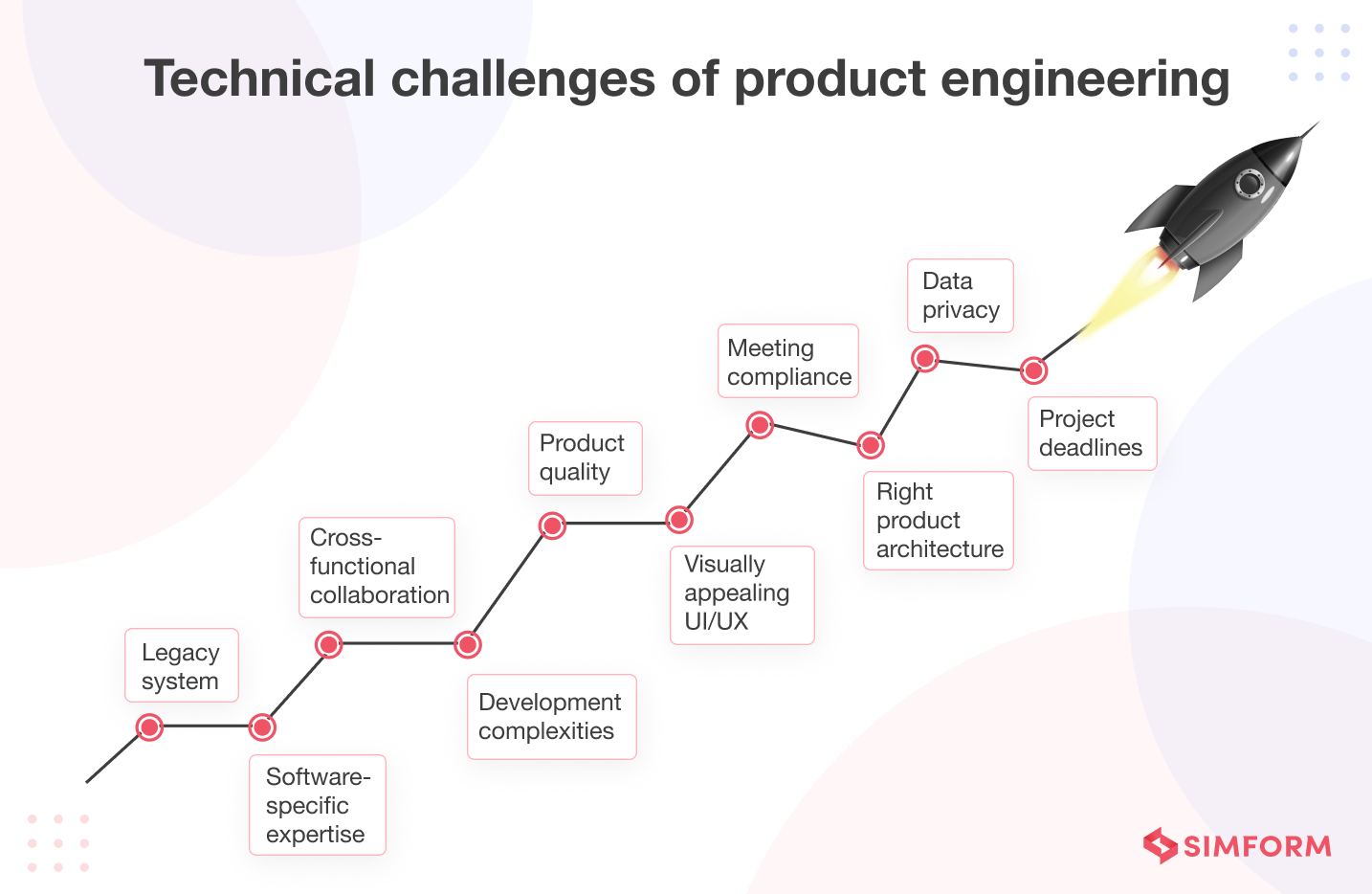
#1. Moving on from the legacy system
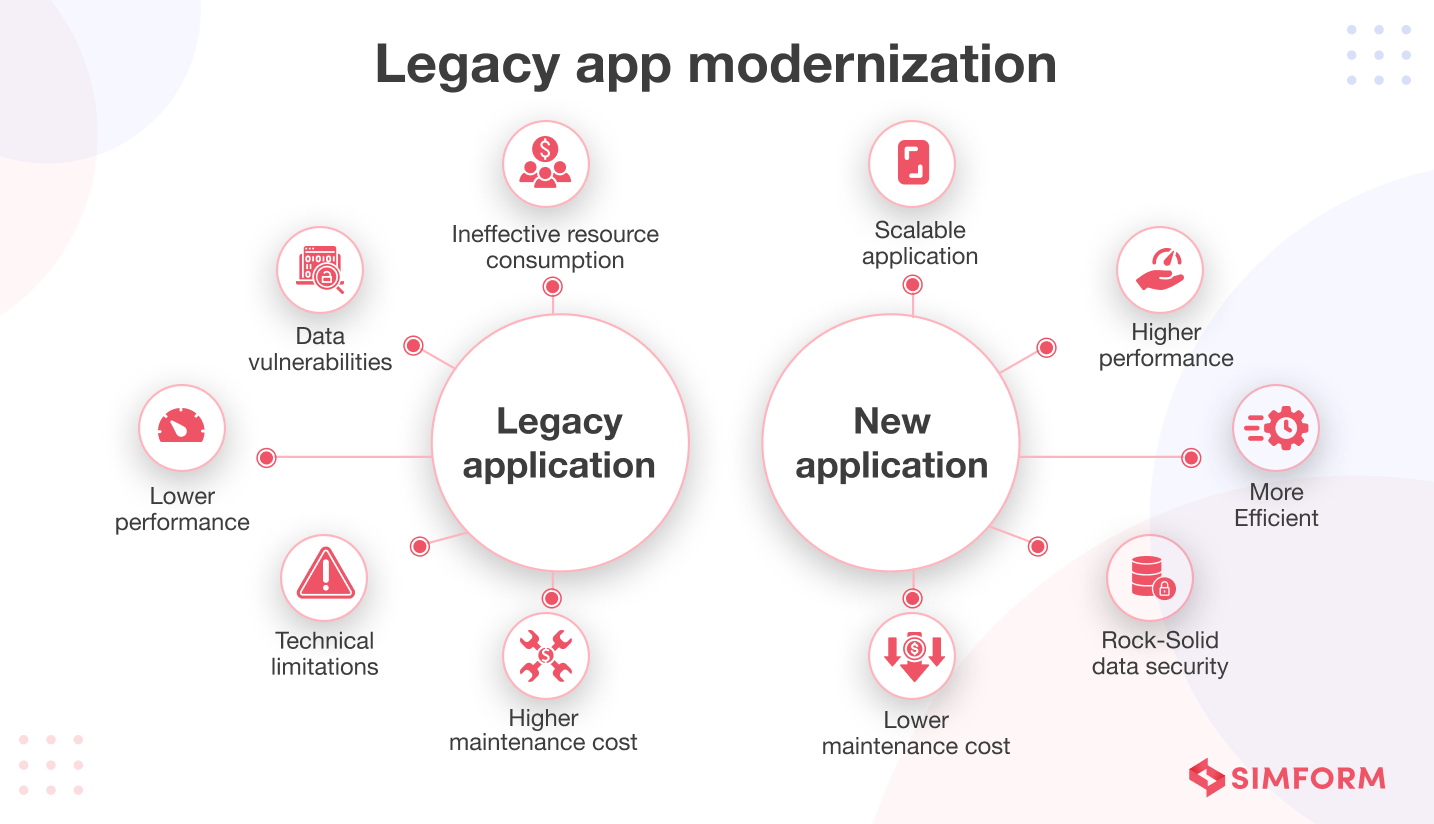
Migration from a legacy system is a product engineering challenge that requires engineers to transition to new technologies, procedures, and workflows. While doing so, your product engineering team must ensure compatibility with existing technologies, smooth data migration, and maintain regulatory compliance. Additionally, product managers must safeguard the reliability and security of new systems while ensuring minimal disruption to business operations.
How can Simform help?
Simform can help clients overcome the challenges of migrating from a legacy system by providing a comprehensive set of digital product engineering services. It comprises assessing the legacy system’s technical debt and identifying the risks and opportunities involved in migration.
We can also create a detailed migration plan that prioritizes critical functionality, mitigates risks, and ensures a smooth transition. Additionally, our engineer’s expertise in cloud-based infrastructure and modern software technologies enables you to leverage the benefits of modern architecture while preserving valuable legacy data and business logic.
#2. Validating software-specific expertise
As a product manager, you must ensure that the company you partner with for the engineering product lifecycle possesses the necessary technical skills to develop the right software. By tech skills, we mean the understanding of programming languages, the right design and development processes, how to leverage the right tools and frameworks, etc.
Furthermore, your technology partner must be proficient in working with agile methodologies and have experience in testing and quality assurance. You can ascertain the software-specific expertise of a development partner by conducting technical interviews, reviewing code samples, and verifying certifications.
How can Simform help?
At Simform, we prioritize our client’s satisfaction and understand the importance of providing top-tier talent. To ensure transparency and maintain high standards, we offer clients the opportunity to conduct thorough technical interviews, code reviews, and certification verification of our team members.
The client can also check our testimonials and case studies to be doubly sure about the projects we have done recently. Our engineering teams are well-equipped with sophisticated technical skills that have helped them leverage agile workflows and high-level quality assurance to deliver superior digital products.
#3. Ensuring cross-functional collaboration
Ensuring cross-functional collaboration is one of the significant product management challenges. It requires effective communication, coordination, and alignment across different functions like design, development, and testing.
It helps you, as a product manager, meet customer expectations and business goals and facilitate cross-team visibility. You must establish clear roles, facilitate open communication, and leverage available tools to ensure effective cross-functional collaboration between siloed teams.
How can Simform help?
Simform ensures cross-functional collaboration for clients by promoting an agile and collaborative approach to project management. We bring together experts from different fields, including development, design, and business analysis, to work collaboratively and provide comprehensive solutions that meet clients’ requirements.
Our engineers also use collaborative tools like Jira, Slack, and Trello to keep everyone on the same page and ensure that projects are delivered on time and within budget.
#4. Managing development complexities
Product development involves numerous interdependent tasks. You must manage resources, timelines, and budgets effectively while ensuring quality, scalability, and reliability in your digital products. Moreover, you have to address technical challenges in new product development and integrate emerging technologies while maintaining system compatibility.
Ultimately, you have to focus on dependencies, mitigate risks, and adapt to changing and final end customers’ customization requirements to ensure successful product delivery.
How can Simform help?
Simform, a leading product engineering company, adopts modern development practices and tools to help product companies overcome development complexities. With our varied experience and deep tech expertise, we provide end-to-end services, including setting development goals, breaking them into sprints, managing the project using agile, leveraging efficient tools and frameworks, and identifying and assessing risks.
We also prioritize rigorous testing throughout the development phase to minimize post-development bugs and errors. Most importantly, we recognize the importance of communication amongst all the stakeholders and ensure the same using various collaboration tools.
#5. Keeping product quality intact
Keeping product quality intact is an important step in digital product engineering. As a product manager, you should implement a comprehensive quality assurance process throughout the product development lifecycle.
It comprises rigorous testing, identifying and fixing defects, and continuous monitoring to ensure the product meets customer expectations. Not dealing with it leads to decreased user satisfaction of customers, negative reviews hampering brand value, and loss of revenue.
How can Simform help?
Simform can help clients maintain product quality by implementing a comprehensive quality assurance process. Our experienced, skillful, and knowledgeable team of QA experts leverages automation, a change management process, and testing tools to identify and fix defects, ensuring product quality meets customer expectations.
Moreover, they also take the assistance of continuous monitoring and iterative testing to prevent quality issues, ensuring robust product delivery to end customers.
#6. Crafting a visually appealing UI/UX
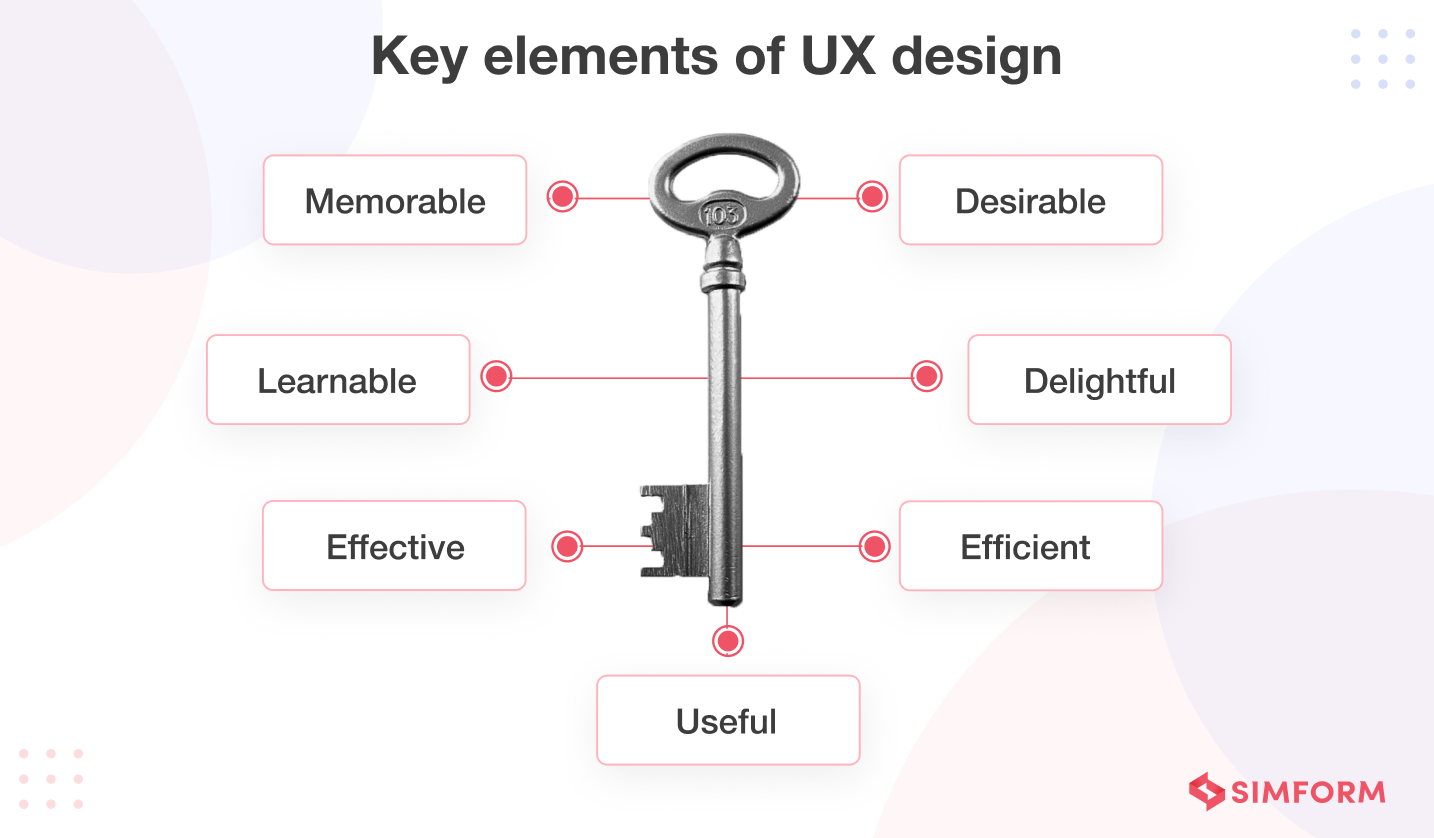
A product design challenge for a product manager is to craft an intuitive and engaging user interface that meets user expectations while providing seamless navigation. It can improve user satisfaction and retention, while a poor design process leads to frustration and abandonment.
Crafting a visually appealing UI/UX requires a product engineer to balance aesthetics with functionality. They must understand the user’s needs, preferences, and behaviors to create an intuitive interface that enhances the user experience while maintaining a visually pleasing design.
How can Simform help?
Simform can help design a visually appealing UI/UX by leveraging user research, prototyping, and testing. Our experienced, innovative, and skillful UI/UX designers work with clients to understand user needs and design intuitive interfaces that provide seamless navigation and functionality.
They also ensure design-thinking consistency across platforms and devices, creating a visually appealing and engaging customer experience. Lastly, we also have designers who can integrate augmented reality and mixed reality into UI/UX and provide a next-level immersive experience.
#7. Meeting compliance or regulations
Meeting compliance or regulatory requirements involves understanding and adhering to various standards and regulations. These are –
- Data privacy laws such as General Data Protection Regulation (GDPR)
- Accessibility requirements such as Web Content Accessibility Guidelines (WCAG)
- Industry-specific regulations such as Health Insurance Portability and Accountability Act (HIPAA) for healthcare and Payment Card Industry Data Security Standard (PCI DSS) for payment.)
Failing to meet these requirements can result in legal consequences, negative publicity, and loss of customer trust. Also, to ensure compliance, you must thoroughly understand relevant regulations and practices that meet these standards.
How can Simform help?
We at Simform can help you to meet compliance and regulatory requirements by implementing strict design and development practices that adhere to industry-specific standards. Our experienced team of product engineers understands various compliance regulations.
So, they can help you navigate compliance or regulations requirements, such as GDPR, HIPAA, PCI DSS, and WCAG, ensuring a compliant and industry-standard product.
#8. Crafting the right product architecture
Crafting the right architecture is one of the significant challenges of product management. You must design a scalable, flexible architecture to meet current and future business needs. Choosing the wrong architecture can lead to performance issues, slow development cycles, and costly rework.
So you must deeply and thoroughly understand business requirements, technology trends, and system integration needs. A well-designed product architecture can improve business performance, scalability, and maintainability.
How can Simform help?
Simform can help clients overcome the challenge of building the right architecture while building a product by providing expert guidance and support throughout the product engineering process. Our experienced architects and engineers work closely with clients to understand their requirements, constraints, and goals and then design a robust architecture that meets those needs.
Our approach includes leveraging best practices in software engineering, such as modular design, scalable infrastructure, and continuous integration and delivery. It enables clients to build high-quality digital products that are flexible, maintainable, and scalable while minimizing technical debt and maximizing ROI.
#9. Assembling the right development team
To assemble the right development team, you must hire the team members with the right skills and experience for the project. You don’t need a team with the wrong mix of skills as that can lead to slow development cycles, quality issues, and project delays.
You need to identify the roles needed, create job descriptions, and conduct a rigorous hiring process to ensure the team is diverse, motivated, and able to work collaboratively. Also, balancing tech skills with communication and leadership skills is vital.
How can Simform help?
Simform offers a team of experienced and dedicated developers who can come quickly on board to help build successful products. Our onboarding process ensures a diverse team with technical expertise, strong communication skills, and leadership abilities. It allows you to save time and resources while getting the right people for your projects.
#10. Creating effective workflow management
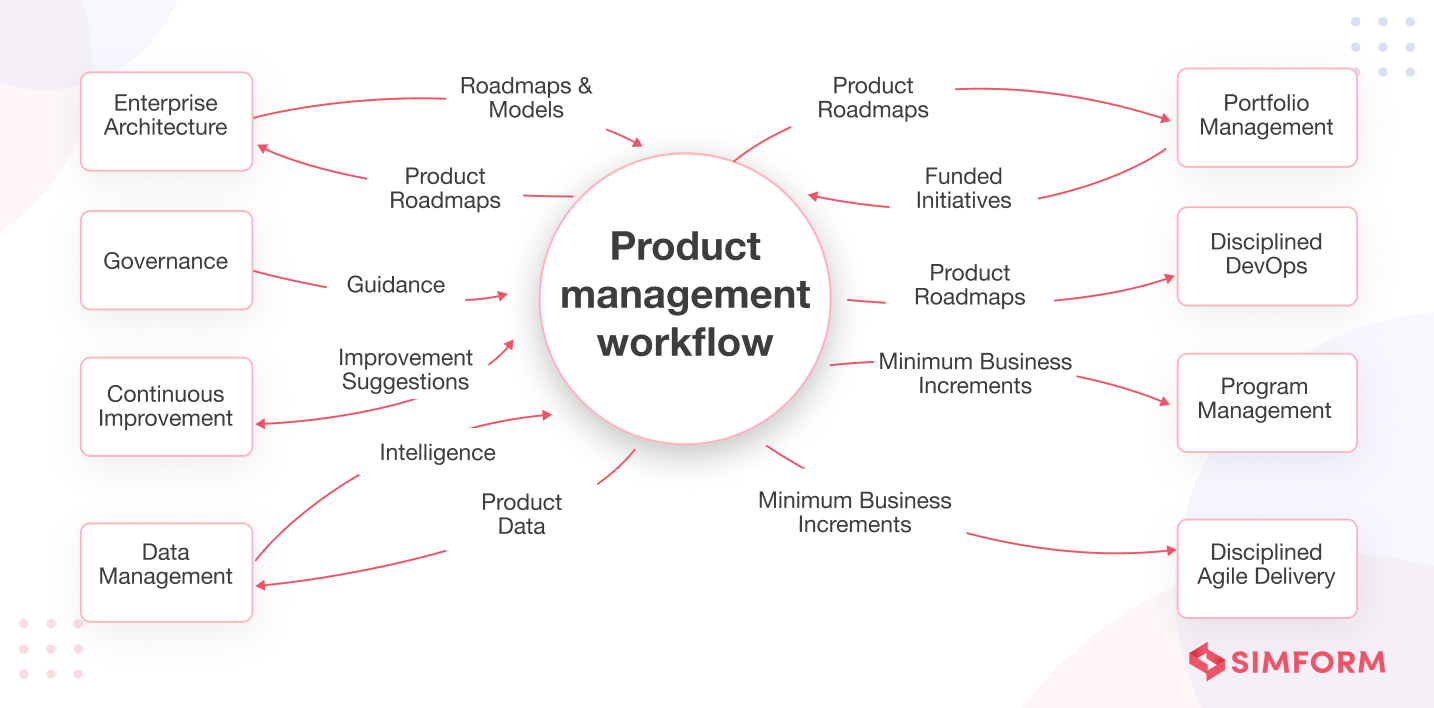
Creating effective workflow involves optimizing the processes for building and delivering products. As a product manager, you need to define clear objectives, set up a process for communication and collaboration between team members, identify and mitigate risks, and use tools and software engineering methodology to streamline the workflow.
Effective workflow management enables you to improve productivity, increase efficiency, decrease design inconsistencies, and deliver high-quality products within deadlines.
How can Simform help?
Our design team helps clients to craft an effective workflow by defining objectives, streamlining communication, and utilizing agile development methodologies. Simform provides tools for project tracking, progress reporting, and issue resolution and prioritizes collaboration to deliver high-quality products efficiently. The approach can help clients increase productivity, reduce development time, and shorten time-to-market.
#11. Keeping up with technological advancement
Many people have questions about how to engineer a product that stays relevant to technological advancement. All product managers must follow current trends with digital technologies, frameworks, and software tools.
Moreover, they should identify and evaluate new technologies, update legacy systems, and implement modern best practices to ensure the product stays relevant.
How can Simform help?
Simform encourages continuous learning and adoption of new technologies, frameworks, and best practices in our daily development activities. Our engineering teams stay up-to-date with industry trends to ensure clients get the best tech solutions for their projects.
Nowadays, our engineers are focused on integrating cognitive technology such as AI, ML, NLP, blockchain, etc. into their development processes to enhance efficiency of both the process and the product.
#12. Dealing with data privacy issues
Data privacy issues involve protecting user data from unauthorized access, misuse, or theft. Product managers must implement secure data storage and transmission practices, comply with regulatory requirements, and train employees to handle sensitive data appropriately.
Additionally, they must keep up-to-date with emerging data privacy threats and adopt measures to mitigate them. Not dealing with data privacy issues can lead to legal and reputational consequences.
How can Simform help?
Our engineers deal with data privacy issues by implementing security best practices, complying with regulatory requirements such as GDPR and CCPA, and ensuring your data is secure during storage and transmission.
Simform performs regular security audits, provides employee training, and implements measures to mitigate emerging data privacy threats. These practices help us to safeguard user data and protect clients from legal and reputational risks.
#13. Managing project deadlines
As a product manager, you must ensure that projects get completed within the set time frame while maintaining quality standards. For that, you have to emphasize effective planning, setting realistic timelines, identifying potential roadblocks, and having a flexible approach.
Using project management tools can help track progress and identify improvement areas to shorten development phases. Failure to manage project deadlines can lead to cost overruns and decreased productivity.
How can Simform help?
Simform manages project deadlines by following a structured project management methodology. It includes breaking down the project into manageable tasks, setting realistic timelines for each task, and tracking progress against the plan.
Additionally, our engineers maintain open and transparent communication with clients throughout the project to manage expectations and mitigate potential delays or risks. Finally, Simform leverages its experienced and skilled team to ensure that each task is executed efficiently and effectively to meet the project’s deadline.
So far, we have understood the various product engineering challenges that deal with the technical side of your product development. However, there are many business challenges that you need to overcome for successful product delivery. In the upcoming section, we have highlighted some of those in detail.
2. Business challenges in product engineering
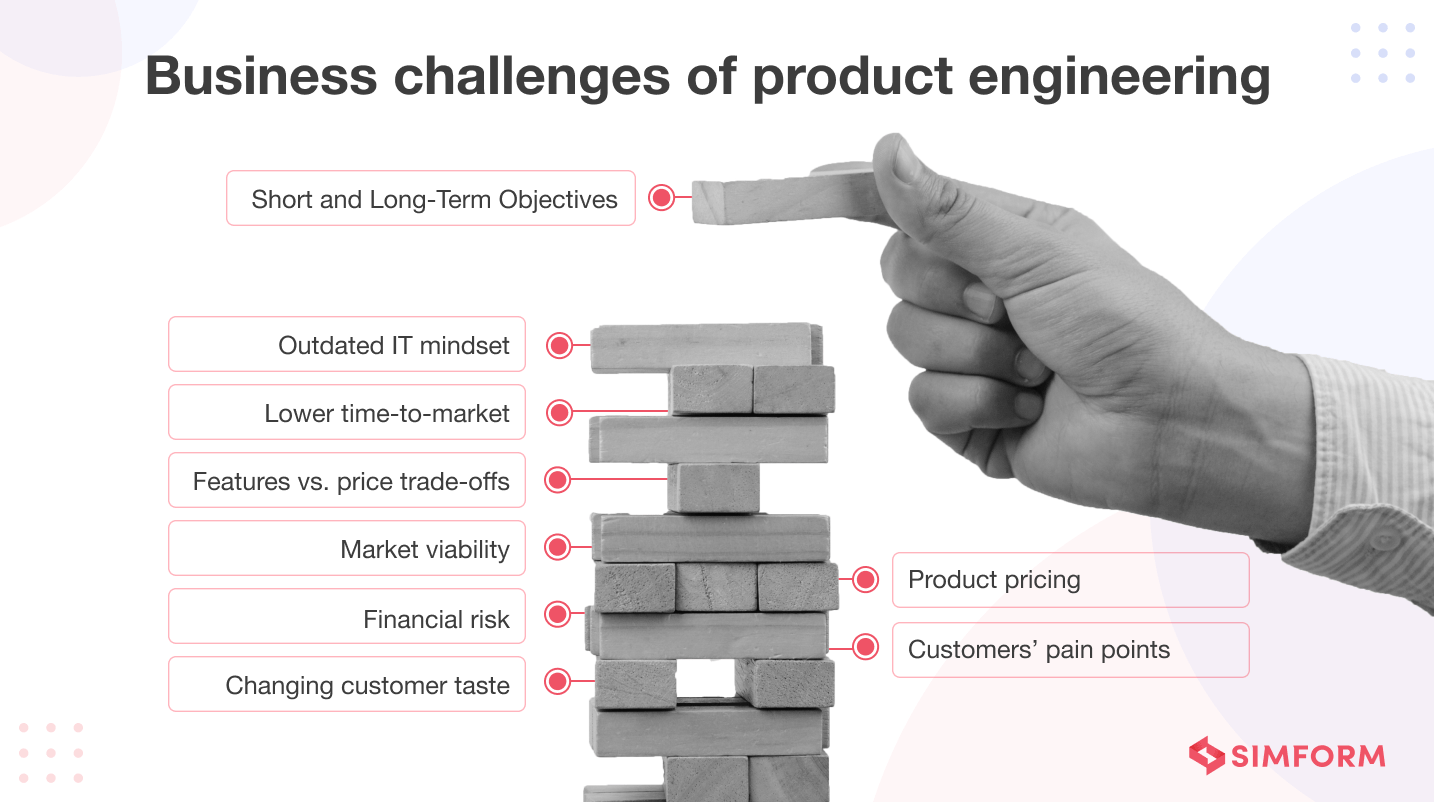
#14. Striking a balance between short and long-term objectives
As product managers, you should focus on managing immediate project needs while planning for future growth and sustainability. Accordingly, you need to prioritize features based on customer needs and market trends, identify opportunities for innovation, and ensure that the product roadmap aligns with the business’s long-term vision. You can miss opportunities or develop an unsustainable product if you fail to balance short- and long-term goals.
How can Simform help?
Simform strikes the right balance between clients’ short-term and long-term goals by focusing on delivering value at every stage of the project. Our engineers work closely with clients to understand their business objectives and develop a roadmap that aligns with their short-term and long-term goals.
Additionally, we prioritize building scalable products that can adapt to changing business goals while ensuring that the product meets immediate needs too. It helps our clients realize tangible short-term benefits while also laying a foundation for long-term success.
#15. Dealing with an outdated IT mindset
Many established companies have great existing products but are not well-versed in technologies. Convincing them to innovate with software product development would be a challenge. Outdated IT mindsets can lead to decreased productivity, increased costs, and an inability to meet customer demands.
So, to remain competitive, product managers must deal with resistance to change, modernize legacy systems, and adopt new technologies. They need a cultural shift towards innovation and collaboration while also investing in employee training and development.
How can Simform help?
Simform deals with an outdated IT mindset of product companies by identifying areas of improvement, fostering a culture of innovation, and investing in employee training and development.
Our engineers have the expertise in modern technologies, tools, and methodologies to help you transition to the latest technology stack to improve your final product. We have a team of industry experts who can solve your doubts about digital transformation and ensure a seamless migration to the latest technologies.
#16. Ensuring lower time-to-market
To ensure a shorter time-to-market, your company’s ability to develop innovative products rapidly without compromising quality comes to the fore. The product managers must streamline development processes, utilize agile methodologies, implement automation, and adopt modern software development practices and tools.
Failure to establish lower time-to-market can lead to missed opportunities and loss of market share to competitors who can deliver end product faster.
How can Simform help?
Simform can lower the time-to-market for its clients through its agile development methodology, emphasizing collaboration, flexibility, and rapid iterations. Our experienced team of developers, designers, and project managers can accelerate the development process, minimize errors, and optimize the product for the market.
We also leverage pre-built components and libraries and use continuous integration and deployment (CI/CD) pipelines to automate the software build, testing, and deployment process, enabling quick identification and resolution of bugs and streamlined software updates, thereby lowering time-to-market.
#17. Balancing features vs. price trade-offs
Product managers must balance the features of a product and its price to ensure it’s attractive to potential customers while satisfying their needs. They can achieve this by conducting market research to understand customer preferences and willingness to pay, prioritizing essential features, considering production costs, evaluating the competition, and testing different price points and feature combinations.
How can Simform help?
Simform takes a consultative approach to understand the client’s requirements and budget and then provides them with a solution that meets their needs while staying within their budget. We have a team of experienced professionals who use their expertise to recommend features essential for the product’s success and those that can be added later. Our experts follow a transparent pricing policy, ensuring clients know what they are paying for and what they will get in return.
#18. Understanding market viability
As a product manager, you must research and identify potential customers, analyze their preferences and needs, and determine a market viable product. By conducting thorough market research and competitor analysis, you can gather valuable and accurate feedback from potential customers and develop a product that meets the growing demand. Understanding market viability can lead to successful product development, increased sales, and improved profitability.
How can Simform help?
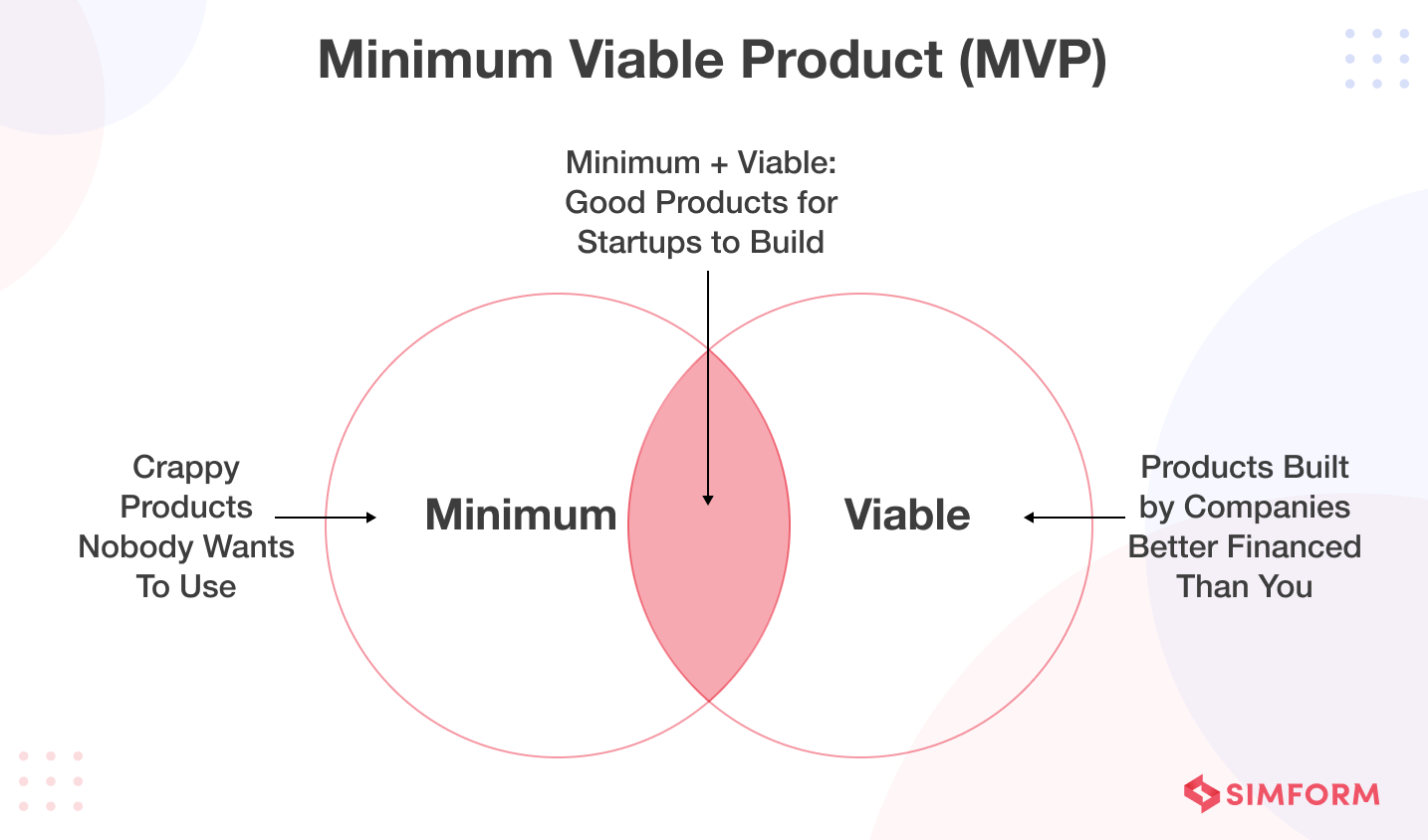
Simform can help you address market viability challenges with extensive market research, prototyping, and user testing. Our engineers’ capabilities will help you to create a Minimum Viable Product (MVP) based on market research.
Based on this MVP, we will help you gather feedback or implement effective review cycles on which things are working and which need further improvement. So, in the end, Simform’s expertise can help you minimize risk, maximize profitability, find a product-market fit, and develop successful products.
#19. Nailing product pricing
Product managers can nail the right product pricing by conducting thorough market research to understand customer needs, preferences, and purchasing habits. They should also analyze the competition to ensure their pricing strategy is competitive.
Additionally, product managers must consider the costs of producing and delivering the product to determine the profit margin. Finally, they can use pricing experiments and A/B testing to determine the optimal price point that maximizes revenue while still being attractive to customers.
How can Simform help?
Simform can help you nail the right product price by conducting market research to understand customer behavior, analyzing costs to determine pricing thresholds, and recommending a pricing strategy that maximizes profits.
Using data-driven insights, our business analysts can be the right decision-makers to provide valuable pricing recommendations to help businesses optimize revenue and remain competitive. Ultimately, we help clients strike an ideal balance between price and profitability.
#20. Identifying customers’ pain points
Product managers must understand the problems or challenges customers face in their daily lives or work and develop profitable products or solutions that address those pain points. Gather customer feedback, conduct market research, and analyze customer behavior to identify patterns and trends. With this analysis, you can create products that better meet customer needs and improve customer satisfaction, increasing sales and profitability.
How can Simform help?
Simform can help businesses understand their customer’s pain points by conducting thorough user research, collecting customer feedback through surveys and interviews, and analyzing customer data to identify trends and patterns.
Our experienced researchers and analysts can help businesses gain insights into their customer’s needs, preferences, and pain points, which can inform product development, marketing strategies, and customer experience improvements.
#21. Managing the financial risk
Managing financial risk is about minimizing financial losses associated with product development, production processes, and product launch. As product managers, you should identify potential financial risks, assess their impact on the product’s success, and implement a risk mitigation product strategy. The major challenge for you is balancing risk-taking with financial prudence to maximize return on investment while minimizing potential losses.
How can Simform help?
Simform can help clients manage financial risk in product engineering by offering expertise in developing robust risk management systems, leveraging advanced analytics tools to identify and mitigate potential risks, and implementing best practices in risk management. Our engineers can also provide real-time monitoring and reporting of financial risks to help clients make informed decisions and stay ahead of potential threats.
#22. Catering to the changing customer taste
Product managers should design and develop products that meet customers’ evolving preferences. With changes in demographics, lifestyles, and market trends, consumer preferences can shift quickly, making it a challenge to stay ahead of the competition.
So, as a product manager, you must understand these changes and use them to create products that satisfy customers’ needs and desires. Be agile and responsive to changing customer demands while maintaining product quality and reliability.
How can Simform help?
Companies can leverage data analytics to identify trends and insights, allowing for more informed product decisions. Simform, as an expert in product development and data analytics, can help you build solutions that provide real-time data analysis and customer feedback.
These insights will enable you to adapt and innovate quickly to meet evolving customer preferences. Our engineers follow the technological changes in the market and provide consultation regarding improvements you should make to keep your products relevant for a long time.
#23. Dealing with resource constraints
Dealing with resource constraints involves developing and delivering high-quality products within the limitations of budget, time, and resources. As a product manager, you must balance the need to create innovative, feature-rich products while optimizing costs and managing available resources effectively.
Identify potential bottlenecks, minimize waste, and streamline development processes to meet project timelines and budgetary restrictions. All in all, you should optimize resources to deliver successful products and achieve long-term profitability.
How can Simform help?
You can leverage Simform’s expertise in agile product development and project management to address the challenge of resource constraints. Our engineers can help businesses to optimize resource allocation and project workflows, identify potential bottlenecks and inefficiencies, and streamline product development processes. It will enable them to deliver high-quality products on time and within budget, maximize their resources and achieve success.
Overcome the most difficult product engineering challenges with Simform
Product engineering challenges can be daunting for any organization, but with the right approach, you can overcome them. You can improve the product engineering processes by designing efficient workflows, ensuring cross-functional collaboration, and leveraging the latest technologies.
Simform’s expertise in product engineering can be invaluable to organizations facing these challenges. With a team of experienced engineers and a deep understanding of the latest technologies and best practices, we can help organizations adopt product engineering best practices and deliver exceptional products.
If you want to overcome product engineering challenges and take your organization’s products to the next level, contact Simform today. With our expertise and product support, you can build better products, streamline your engineering processes, and drive business success. Don’t let product engineering challenges hold you back – take the first step toward success.